Despite being one of the easiest and most accessible hikes along the Icefields Parkway, the walk to Bow Glacier Falls is surprisingly also one of the best. Beginning by winding around beautiful turquoise-blue Bow Lake, the trail starts with brilliant views of the surrounding mountains and distant Bow Glacier waterfall. As it follows the headwaters of the Bow River up the once-glaciated valley towards its source, the forest gives way to the rugged and treeless boulder field left behind by the retreating glacier. Views of the surrounding peaks are superb.
The biggest waterfall on the Icefields Parkway, Bow Glacier Falls is immense as it cascades down a steep 154 m rockwall, drenching hikers below with spray. Interestingly, when the Bow Glacier was discovered in 1898 it covered most of the rock face in ice, but has since retreated to the extent that nowadays the glacier is no longer visible from the base of the falls.
Continue reading this blog post for everything you need to know to experience the Bow Glacier Falls hike in Banff for yourself, including distance, elevation gain, how to get there, the best time to visit, and lots of photos of my experience.
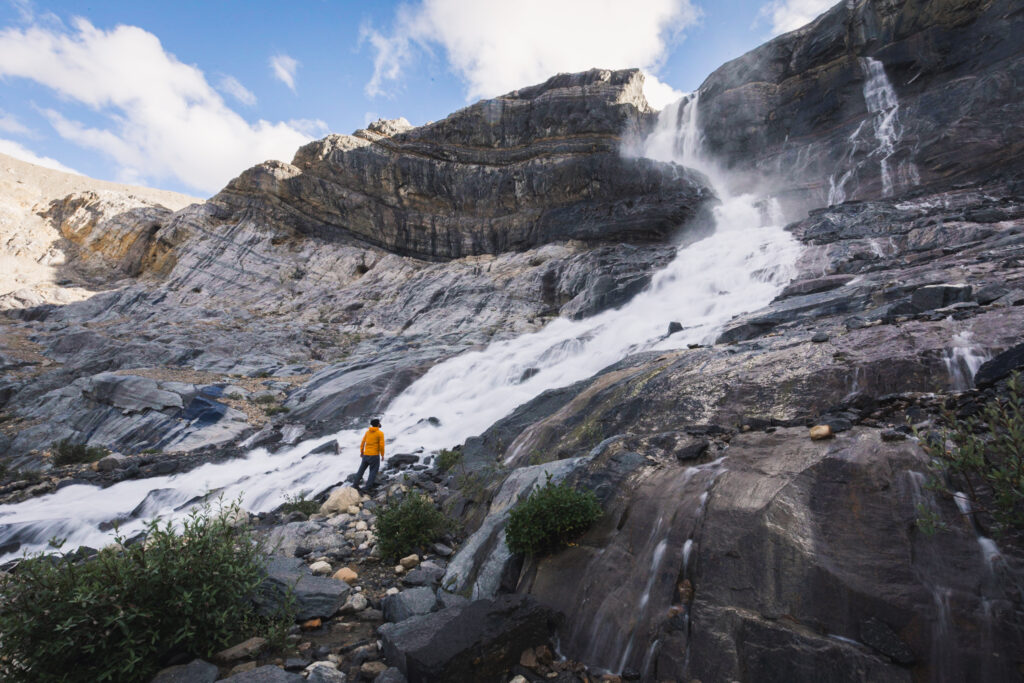
Note: The Bow Glacier Falls hike is located in Banff National Park, meaning that a valid park pass is required. Day passes can be purchased at the park gates and are per day per person, but if you’re staying a week or longer, it’s more cost-effective to just buy an annual pass instead.
Before visiting Banff National Park it’s essential to read up on the Parks Canada rules that must be followed to avoid tickets and/or fines. When hiking it’s important to avoid harmful practices such as disturbing plants or rock-stacking, or removing any natural object from flowers to rocks, as it’s important to leave the environment as natural as possible for the animals and for fellow hikers to enjoy in perpetuity. As many flowers as there are, there are few enough that if we all took one, then there wouldn’t be any left. Take only photos, leave only footprints.
If you haven’t heard of Leave No Trace principles, they’re also really essential to read up on before heading anywhere into the outdoors in general. Following these important principles basically means doing your best to leave beautiful places like Bow Glacier Falls as good (if not better) than you found them, both for their preservation and for the enjoyment of other visitors.
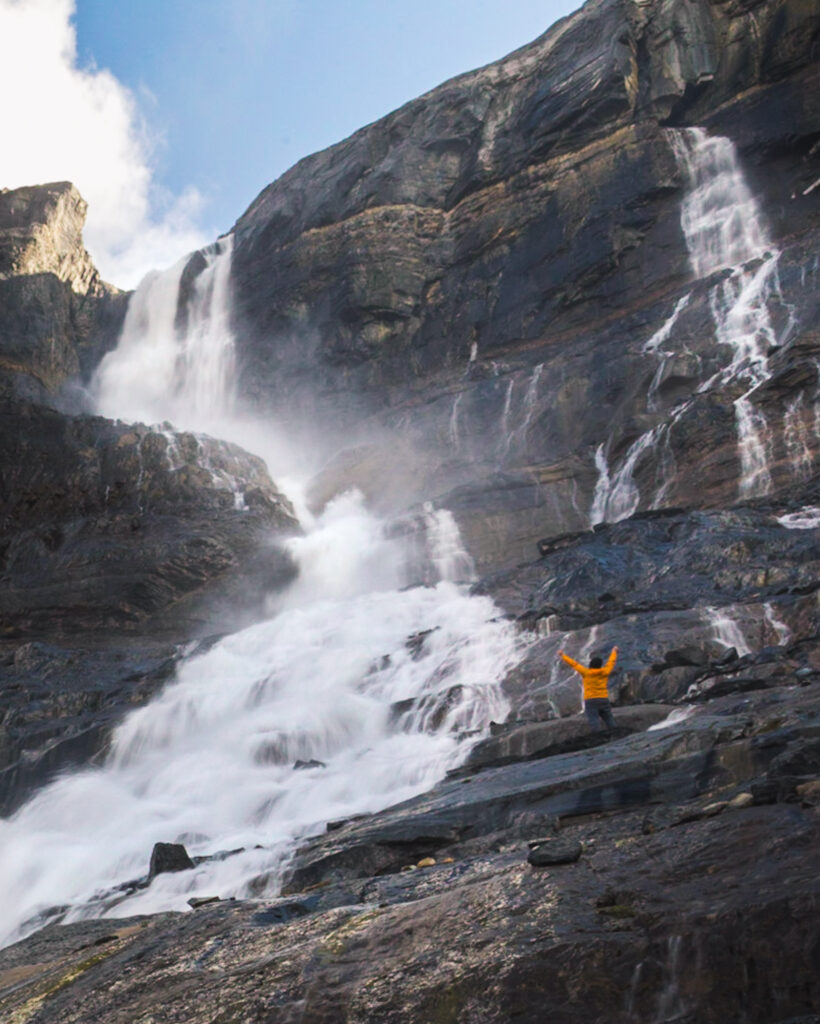
Bow Glacier Falls Round Trip Details
Distance: 9.6 KM / 6 MI
Elevation Gain: 275 M / 902 FT
Hiking Time: 3 Hrs
Hiking & Safety Tips
- Prepare for the possibility of wildlife encounters. Bear spray is a must whenever travelling in bear country, as well as learning how to use it. Though your chance of an aggressive bear encounter is low, it is always better to be prepared with bear spray. Bear bells are proven to be an ineffective bear deterrent, and are actively discouraged by Parks Canada. The best way to let bears know you’re around is simply to use your voice. Make sure to keep a respectful distance from wildlife and never feed the animals. It may seem kind but it doesn’t just kill wildlife and put people in danger, it’s also illegal.
- Research current trail conditions and make sure you are well-informed about the route before you leave, and assess if it is within your capability. Be aware of what time it gets dark and check the weather forecast. Make sure to tell someone where you’re going and when you expect to return. Every year as more and more people try hiking for the first time, the number of rescues goes up. Being prepared is the best defense.
- Pack everything you need for a successful hike, including enough water and energy-rich snacks. Remember to pack out everything you pack in though – don’t expect to find a convenient garbage can halfway up the trail. Bring appropriate layers (remember you’ll warm up once you start hiking) and sun protection. Hiking poles may be helpful but are not required. In addition to not leaving any garbage on the trail yourself, I highly recommend bringing a garbage bag and collecting any trash that you do see on the trail. You’re guaranteed to make the hike to Bow Glacier Falls a more enjoyable experience for the next person.
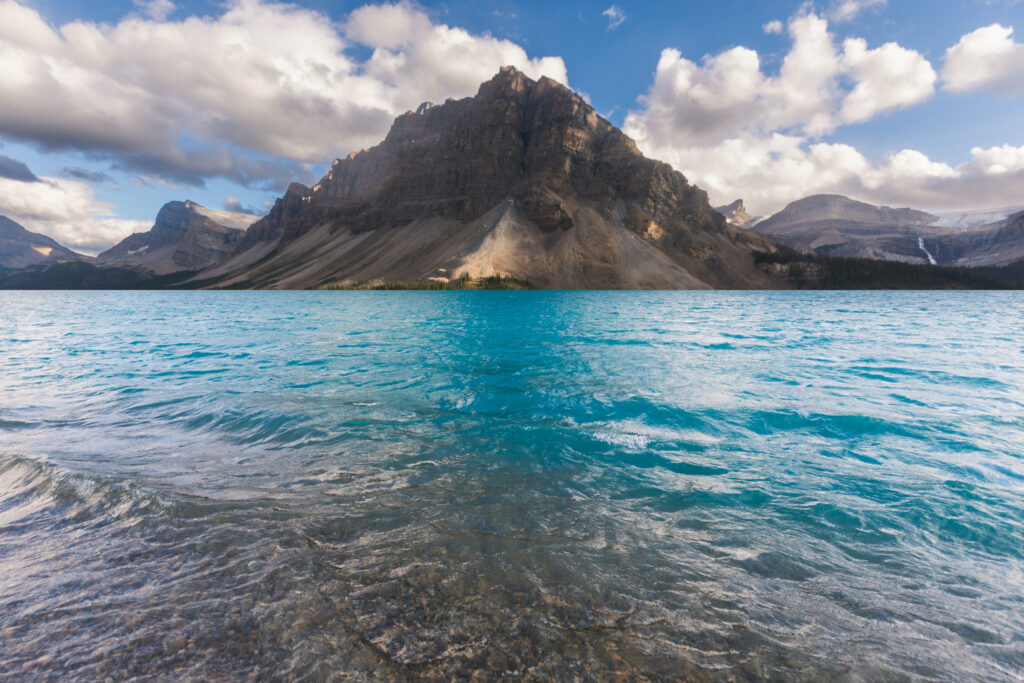
When to Visit Bow Glacier Falls
Like many waterfalls in the Rockies, the best time of year to visit is in late Spring. Melting snow and recent rainfall mean that the water level is at its highest, and the waterfalls at their most dramatic. Later in the year waterfalls lose a lot of their power, with some drying up to not much more of a trickle. Drum Creek Falls never fully dries up and to the best of my knowledge flows decently year round, but if visiting in late summer or autumn either try and time your visit with recent rainfall or lower your expectations accordingly.
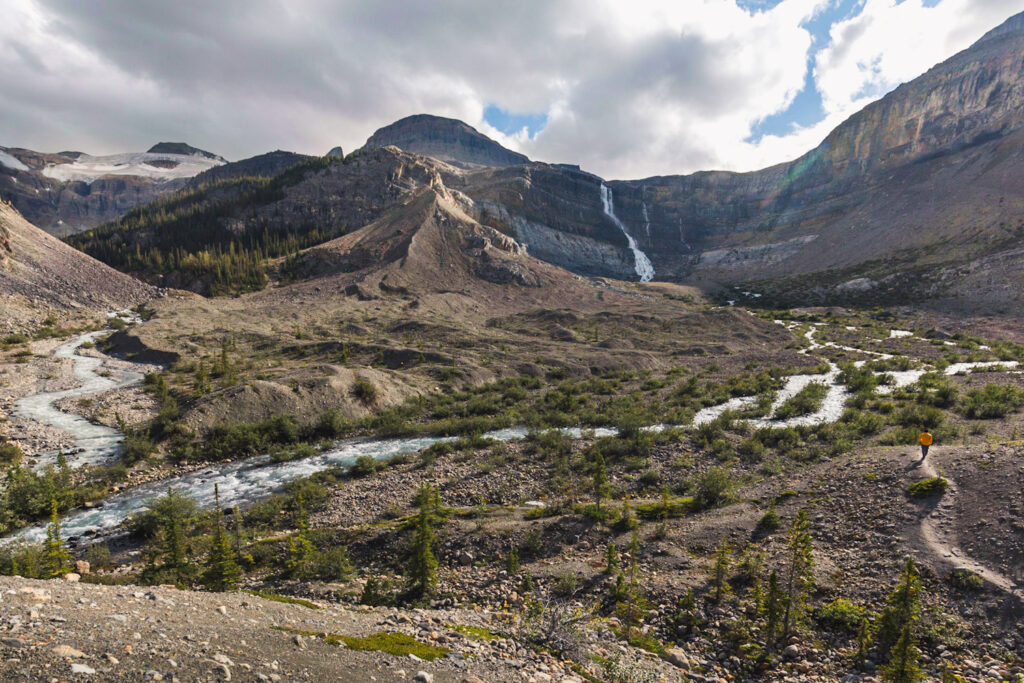
How to Get to Bow Glacier Falls Trailhead
The Bow Glacier Falls hike starts from the Bow Lake parking lot, next to the Bow Lake Lodge. The lake is popular among tourists stopping to visit the gift shop, so the well-signed turnoff from the Icefields Parkway is hard to miss. Bow Lake is half an hour north of Lake Louise and an hour from Banff, or two hours south of Jasper.
Click here to open the exact trailhead location in Google Maps.
Hiking to Bow Glacier Falls

Setting off from the Bow Lake parking lot past the Lodge. The area is pretty crowded but once past the gift shop and on the trail it becomes pretty quiet. Bow Glacier Falls is already visible in the distance from the parking lot.
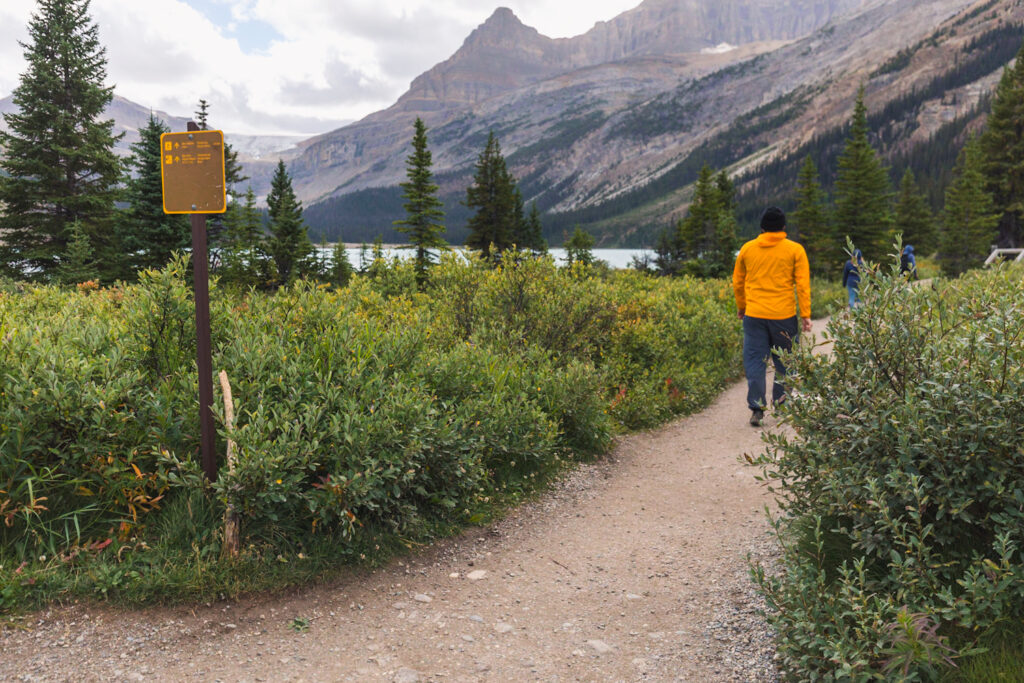
Just past the Lodge, the trail continues closely alongside the lake. Portal Peak rises above the lake.
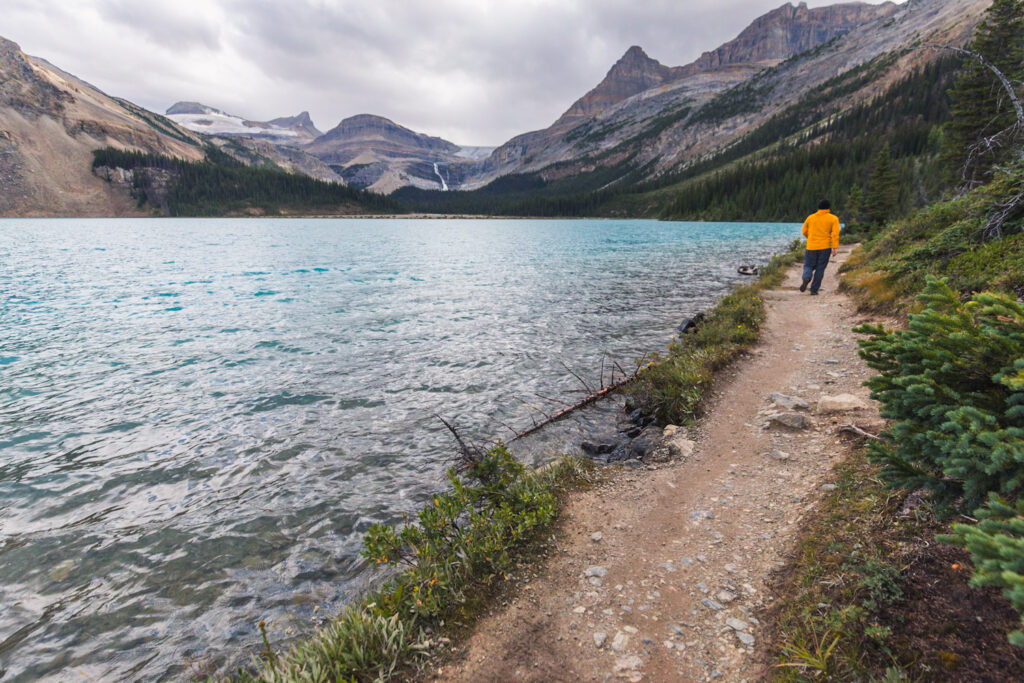
The trail follows closely alongside the incredibly blue Bow Lake.
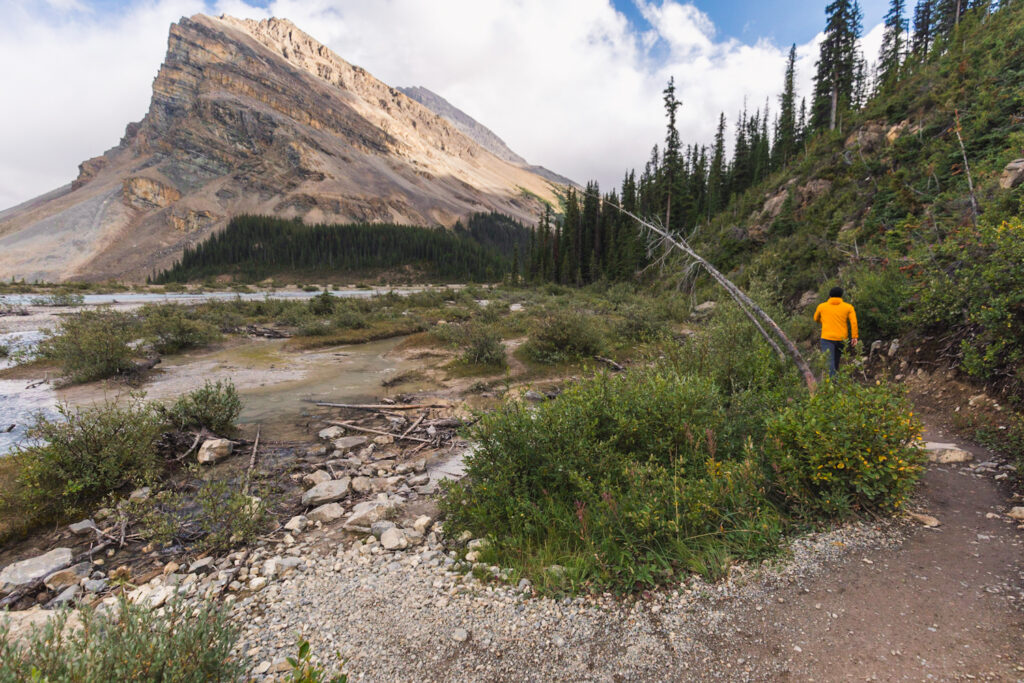
At the end of the lake it’s very easy to miss this split in the trail. The path on the left gets a bit muddy and the path on the right gets rooty as it heads up into the woods to go around the muddy area.
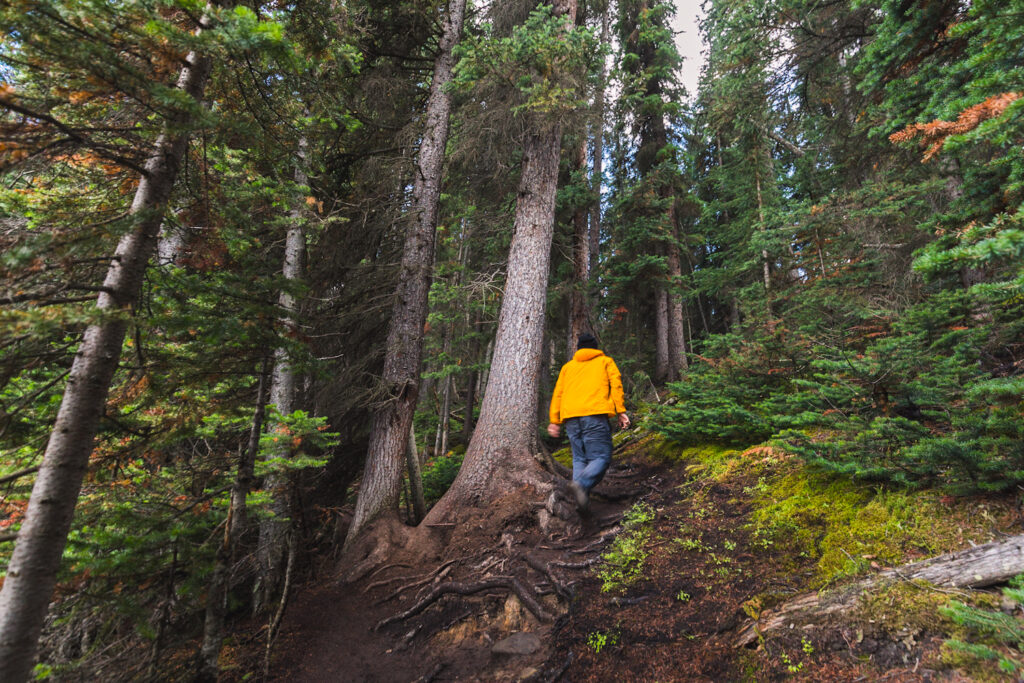
Headed up the obvious trail from the small parking lot. The aforementioned rooty area.
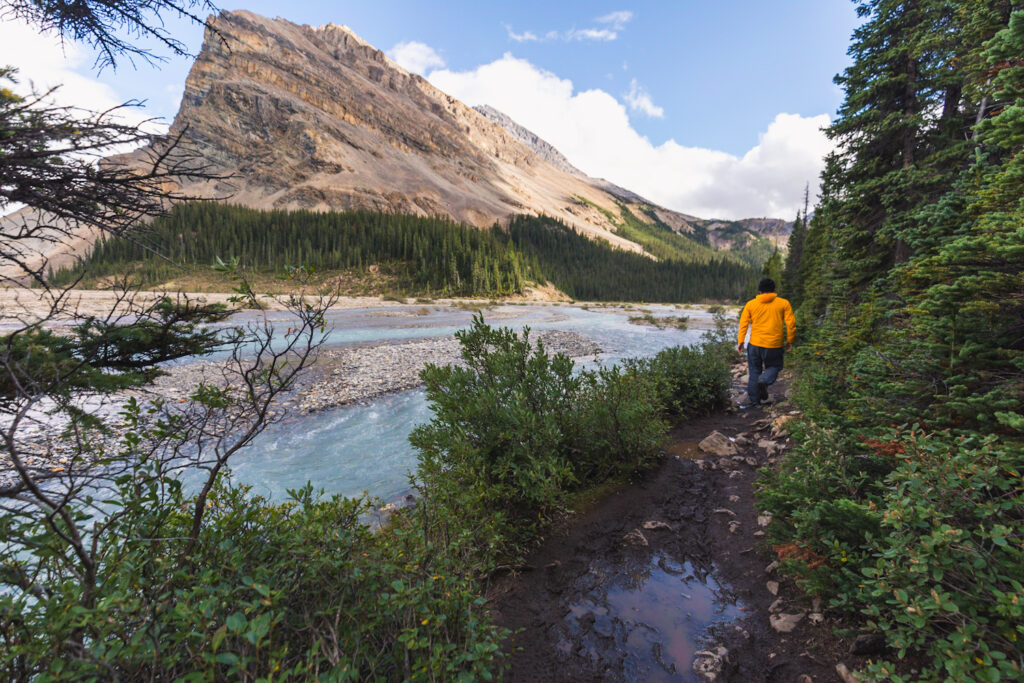
The trail continues alongside the headwaters of the Bow River which drain from the glacier towards Bow Lake.

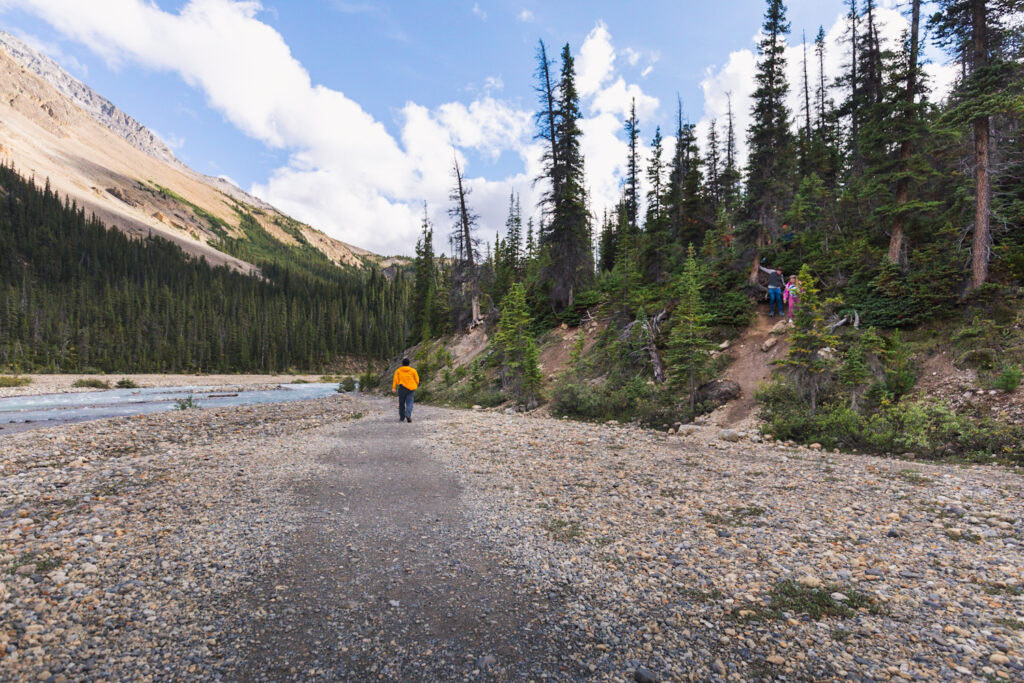
Stay on the trail. The hikers visible in this photo ended up on the wrong trail and got stuck trying to get down the steep hillside, trampling plants and eroding the hill.
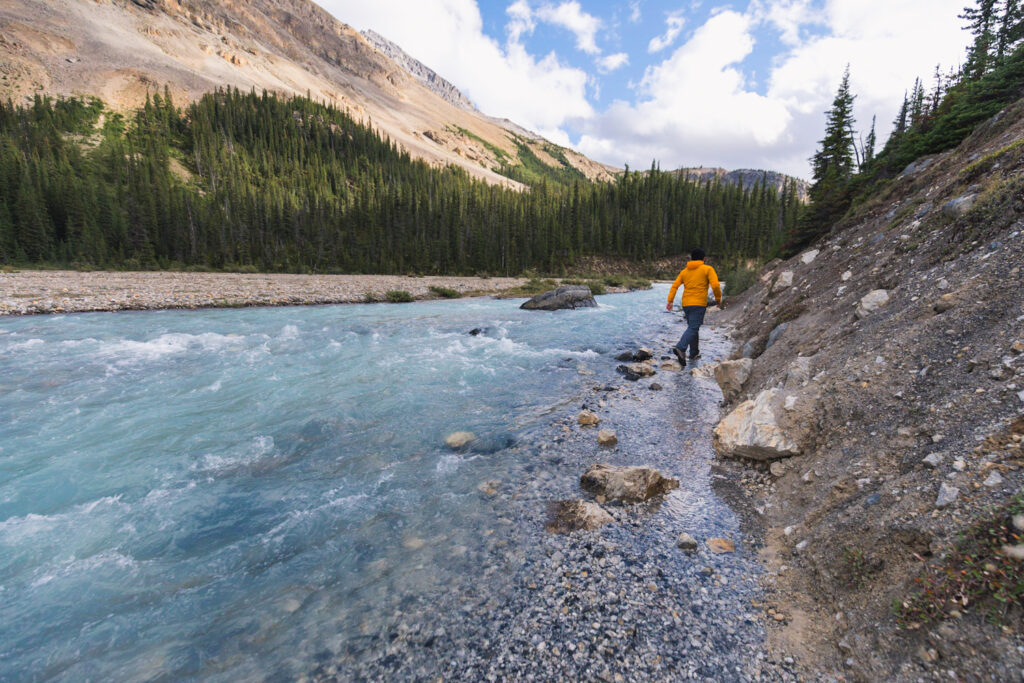
The trail got a little wet but it was only an inch or two deep. It was mostly possible to keep feet dry by hopping from rock to rock.
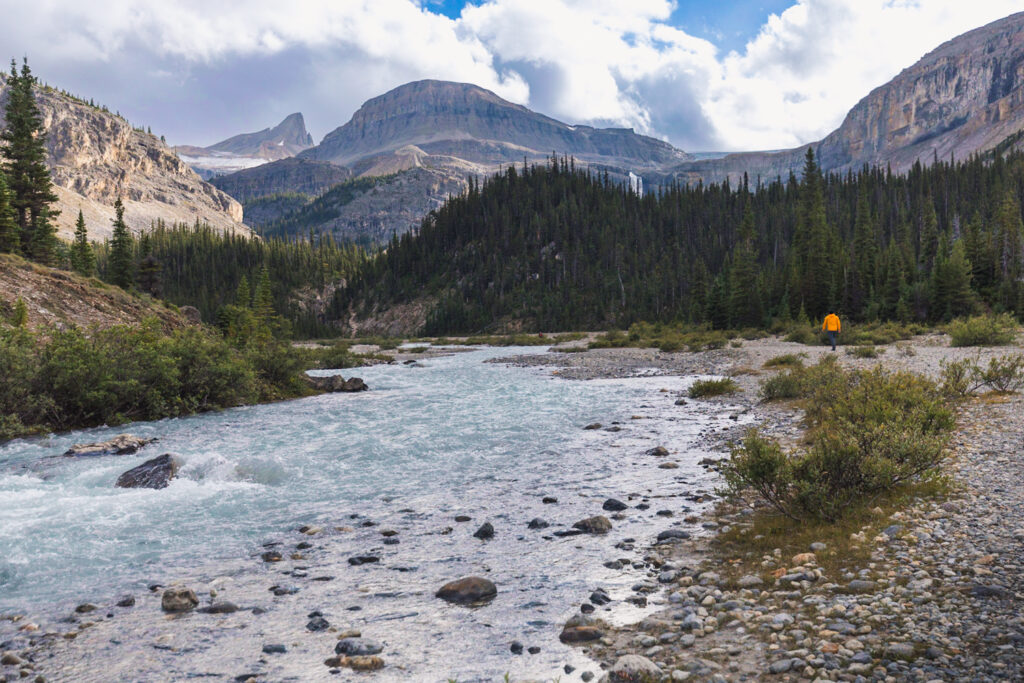
The flats open up again before heading into a canyon to the left of the treed hill ahead of me.
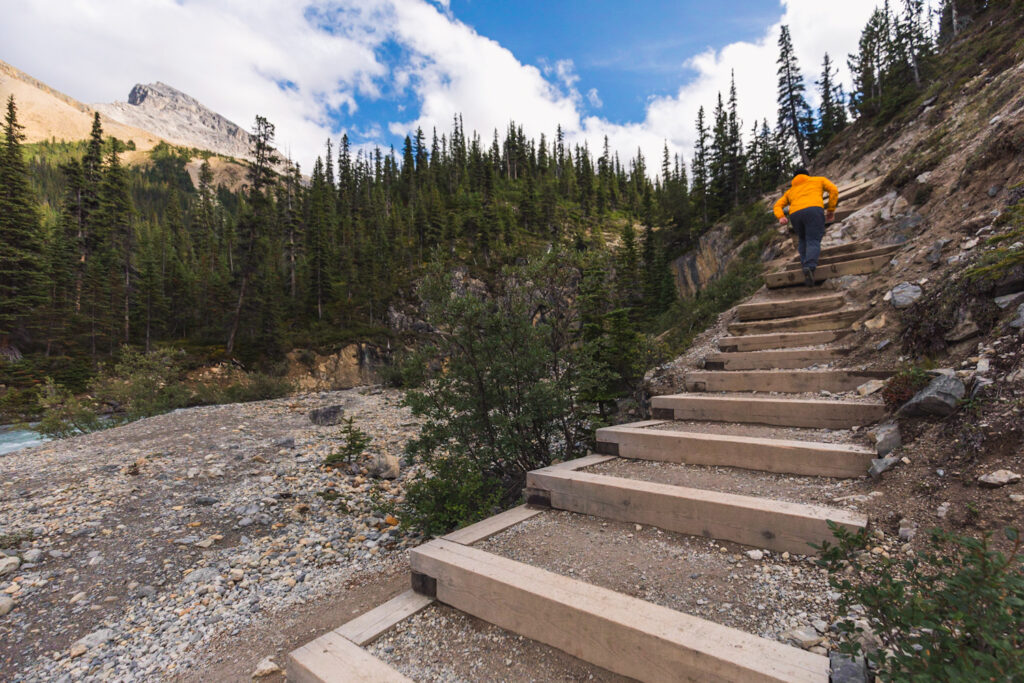
The trail steeply climbs up alongside the canyon that the water gushed out from. After an almost completely flat trail up to this point the sudden elevation gain is a bit of a shock.
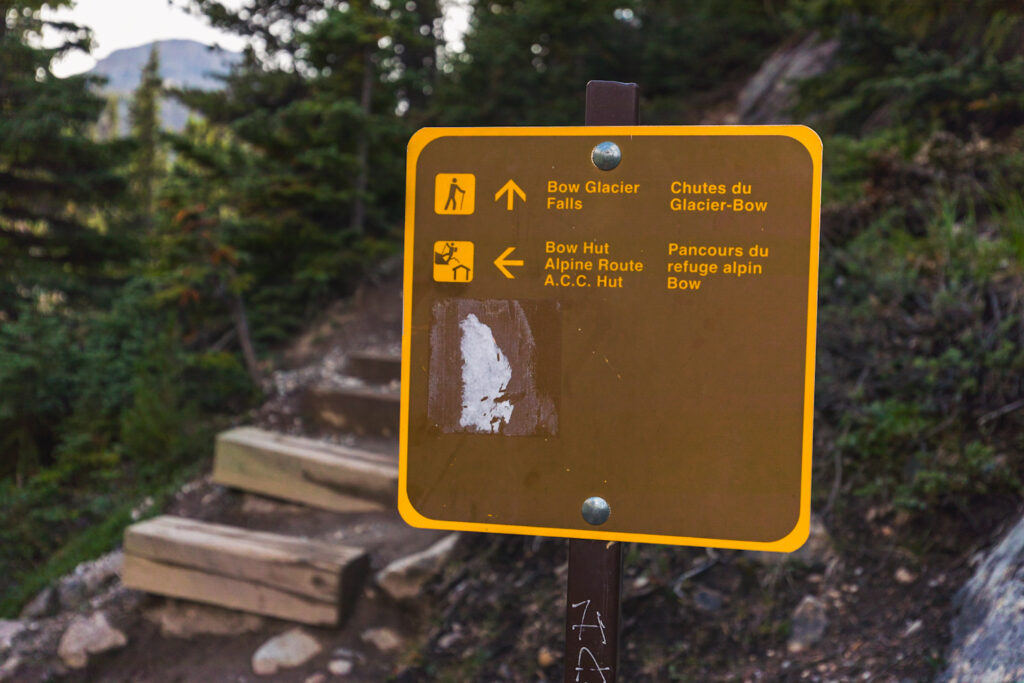
For a good view down into the canyon, take a brief detour to the left at this intersection.

The trail to the ACC hut crosses the canyon via this large chockstone.
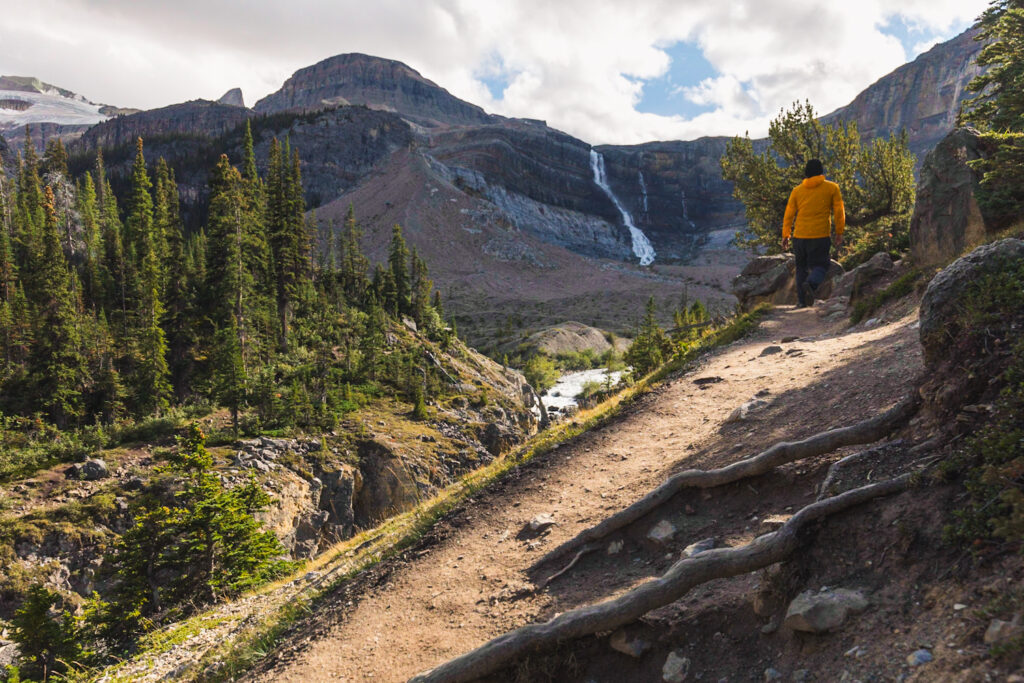
Continuing up alongside the canyon, the headwall with Bow Glacier Falls cascading down it comes back into view.

The trees slowly get younger and younger as I follow the path of the glacier’s retreat. Eventually this will be a green forested valley just like any other in Banff but for now it’s still rocky and barren.
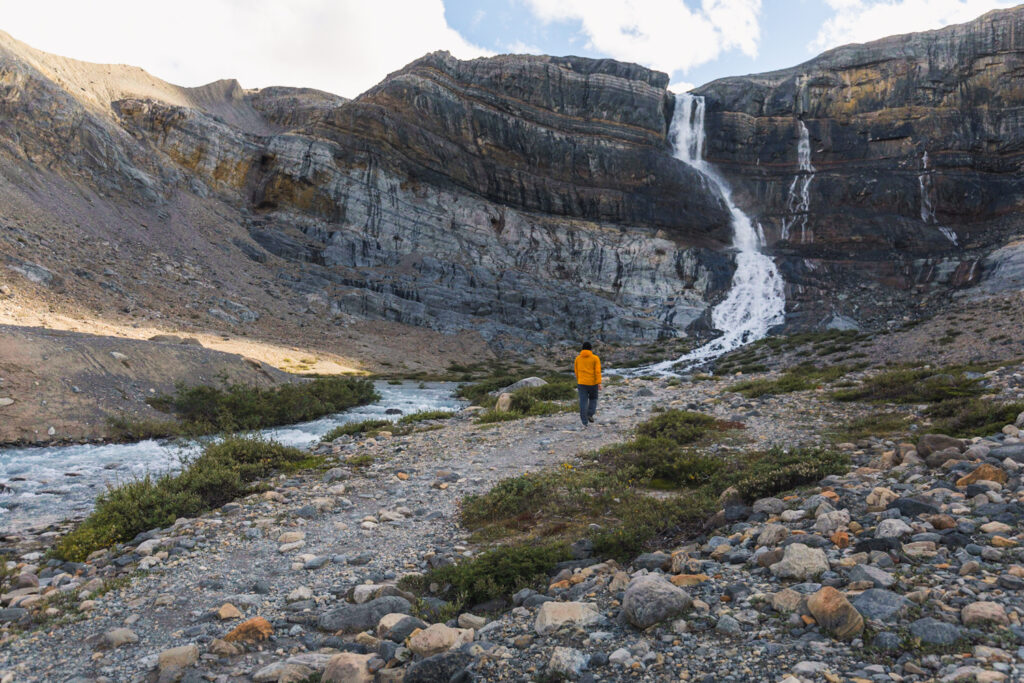
The trail gets a little difficult to follow as it gets closer to Bow Glacier Falls but it’s easy to figure out which direction to walk in.
Recommended Hiking Gear



Water is a must whenever I’m hiking, especially if the sun is going to be out. My favourite water filter I’ve used is the Katadyn BeFree 0.6L, which unlike other water filters I’ve used packs up really small and lightweight. For hikes where I know there won’t be any readily available water sources along the way, I make sure to bring my own. The Hydrapak Stow 1L bottle is my go-to, for the same reason that it’s made of a soft plastic that folds up and doesn’t take up any more extra space than necessary in my pack. Finally, Aquatabs are another great option for purifying water, with one tablet being suitable for one litre of water. I previously used the Grayl water filter while travelling internationally, and though I found its hard body more convenient for day to day use and easier to drink from, it has a little too much bulk for my fast-and-light style of hiking.



The secret to all my photos of gorgeous sunset and sunrise mountaintop views? A lot of hiking in the dark. And let me speak from personal experience when I say that the last thing that you want to happen when hiking is to be caught in the dark without a headlamp. I used the Black Diamond Spot 400 for years and it worked great – until I lost it on top of a mountain somewhere. The only downside to it was having to worry about the batteries dying, though there’s also a slightly more expensive version that has a rechargeable battery. Nowadays I’m using the Petzl Actik Core, which is a bit pricier than the more budget-friendly Black Diamond, but is also brighter, more comfortable (in my opinion), and has a hybrid power system that is rechargeable but can also take AAA batteries if needed.
You won’t see me using trekking poles on shorter hikes often – but on long hikes and backpacking trips, as well as certain scrambles, they are an absolute lifesaver. I’ve invested in a high quality ultra-lightweight pair of MSR DynaLock Ascent carbon poles which, while pricey, I don’t regret one bit. If you’re not entirely sure how much use you’re going to get out of a pair of trekking poles, the best budget-friendly option would be the Trekology Trek Z 2.0. Amazon does sell a lot of cheaper Made in China-style trekking poles for cheaper, but these usually are much much heavier and not worth buying.
All the best and most long-lasting cables and power banks I’ve ever owned have been Anker. I once had a phone cable from them that lasted me over three years of daily use! That’s why I keep an Anker PowerCore Essential 20K power bank on me. Like many people I use my phone for a lot of stuff when hiking (checking in with family, using online maps, taking photos, flying my drone) so I like to be prepared for that low battery warning by having a backup power source on me just in case.



The only socks I ever buy for myself are from Darn Tough, and I almost always make sure to wear them when hiking. After years of having no problems only wearing these comfortable and rugged socks for hikes, I accidentally wore a pair of no-name socks on a hike last year and ended up with blisters on both feet. Safe to say I’m back to sticking with the Darn Tough. And the best part? They have a lifetime guarantee, meaning that if they ever wear out you can send them back for a brand new pair. For hiking footwear I go between a pair of lightweight approach shoes for quick and dirty mountain ascents or anything involving scrambling and more heavy-duty boots for longer treks. I’ve worn a couple different versions of the lightweight but super durable Arc’teryx Konseal FL 2 approach shoes for a few years now and am very impressed with the durability. I also really like the thick toecap that keeps me protected every time I stumble into a root or large rock. For longer, tougher, or muddier treks I rely on my LOWA Camino EVO GTX, which I find insanely comfortable and made of very high quality.



I wear my Ar’teryx Gamma Lightweight Pants on every single hike I go on, and on many days when I’m not hiking. After several years of abuse they are still holding together extraordinarily well, with only a few small holes from where I’ve fallen down and some slight stains from being repeatedly coated with mud. They’re lightweight, breathable, and super comfortable. For lightweight and breathable hiking tops I’m a big fan of both the Patagonia Capilene Shirt and the MEC Core Shirt. My Arc’teryx Squamish Hoody shows up in a lot of my photos. It’s super lightweight and packable, and does a great job of cutting the wind while also being pretty breathable. I also have an Arc’teryx Atom Hoody and Arc’teryx Beta LT that I pull out for cooler or wetter conditions.
I hope you enjoyed this guide to hiking to Bow Glacier Falls in Banff National Park! Feel free to leave any questions in the comment section below or to contact me directly via social media.

You’ve got round trip to bow glacier falls listed as two kilometers. That sounds way off
Whoops, definitely way off. Thanks for the correction, I appreciate it!